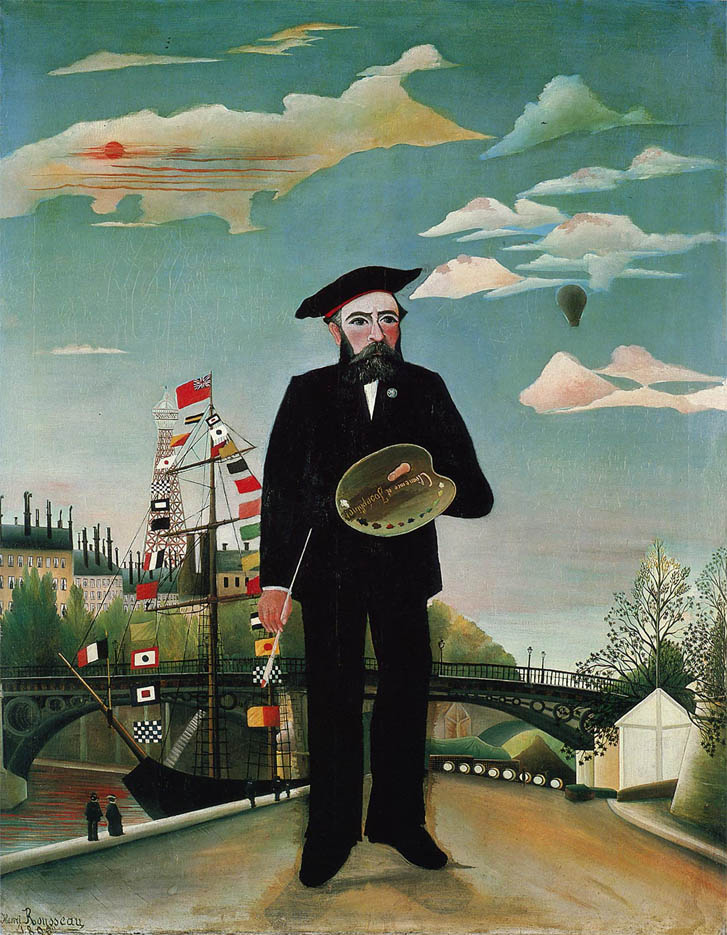Musée
d’Orsay, Paris
Through
17 July 2016
By
comparing this artist’s painting with several of his sources of inspiration: academic painting, new painting and
the avant - garde artists who enthroned him as the father of modernity, The Douanier Rousseau. Archaic Candour exhibition
will shed a critical light on his art by reflecting on the notion of archaism. Works by Paul
Gauguin, Pablo Picasso, Carlo Carrà, Diego Rivera, Max Ernst, as well as other
lesser - known or anonymous artists will evoke the wealth of interconnections woven
around the Douanier Rousseau, the catalyst who stimulated an original way of
exploring modernity.
The
emphasis is on the Douanier Rousseau’s
fundamental role in asserting the
Parisian and the international avant - garde:
Picasso, Delaunay, and the artists of the German avant - garde, at the
forefront of which was Kandinsky. These artists not only admired Rousseau’s work and took him as a source of
inspiration for their own work, but also
collected his paintings.
Moi - même, portrait - paysage [Myself,
Landscape Portrait]
(1889 - 1890, Prague, Narodni Galerie)
and
the Portrait
de Monsieur X (dit Pierre Loti)
[Portrait of Monsieur X] [Pierre Loti] (1906, Kunsthaus Zürich)
announce,
at the start of the exhibition, the
uniqueness of the work of the artist who asserts that he invented the
“landscape - portrait” genre: in fact, this style goes back to the portraits of
the old masters, demonstrated in
le Portrait d’homme au bonnet rouge [Portrait of an
Unknown Man with a Red Beret] by Vittore Carpaccio (Venice, Museo Correr);
this
work would, in turn, influence several generations of artists such as Fernand
Léger who took his inspiration for
Le Mécanicien [The Mechanic] (Montréal, Musée des Beaux - Arts) from Portrait de Pierre Loti.
Designed
around this dialogue between echoes of the past and anticipation of the future,
the exhibition is set out along the recurrent themes in the painter’s work:
still landscapes, populated with anonymous figurines and “homage” to the new modernity of airplanes and
airships, still lifes and portraits of solitary, and often disturbing, children
( Pour Fêter bébé ! [To Celebrate the
Baby!],
1903, Wintherthur, Kunstmuseum),
which
had made a deep impression on Picasso and Carrà in particular. This “family” dimension in his art developed
in parallel with his dreamlike images of a ild and savage world : masterpieces such as
An
extremely unusual painter, Henri Rousseau is a unique figure in the history of
European art. His work is, however, in keeping with his time, the dawn of the
20th century. Far from being yet another
celebration of the Douanier Rousseau’s naïve style, the exhibition aims to
show how much his work belongs within a western art movement which, in both America and Europe,
from the 16th
century until the
first decades of the 20th, adopted a stylistic model that was archaic, by setting
– consciously or otherwise – an “anticlassical” painting against the “official” painting of the various epochs.
Henri
Rousseau, known as The Douanier Rousseau
(1844 - 1910) Le Rêve [The Dream] , 1910, oil on canvas, 204.5 x 298. 5 cm New York, The
Museum of Modern Art, gift of Nelson A.
Rockefeller, 252.1954 © 2016. Digital image, The Museum of Modern Art, New York
/ Scala, Florence
Le Rêve [The Dream] (1910, New York, MoMA),
a
fantasy vision heralding the atmospheres of Surrealism, will be displayed
alongside
Jungles (Le lion, ayant faim , se jette sur l’antilope) [Jungles (The Hungry Lion throws itself on the Antelope], Bâle, Fondation Beyeler).
Jungles (Le lion, ayant faim , se jette sur l’antilope) [Jungles (The Hungry Lion throws itself on the Antelope], Bâle, Fondation Beyeler).
“Enormous
compositions in which the grotesque goes
together with the tender, the absurd with the magnificent”, as Ardengo Soffici
wrote in 1910, they remain a testimony
to this visionary artist with “the innocent eye of a child”.
From an excellent Wall Street Journal review (images added):
From an excellent Wall Street Journal review (images added):
...Rousseau’s ambitions were never circumscribed by his archaizing style, a poetic and simplified realist mode that eschewed such academic conventions as three-dimensional illusionism and one-point perspective. In
“The Representatives of Foreign Powers Coming to Salute the Republic as a Sign of Peace” (1907), which echoes in its staid format and subject the official art of his master Gérome, Rousseau aspired to create a history painting, still the most prestigious genre at the Salon. He hoped it would be acquired by the state. Instead, his canvas, ridiculed at the Salon but purchased by the dealer Ambroise Vollard, was eventually owned by Pablo Picasso. Picasso had already acquired
Rousseau’s 1895 “Portrait of a Woman,” a strangely disquieting, full-length frontal portrait of a flattened, collage-like figure. Picasso described it as “one of the most truthful French psychological portraits...”
The exhibition builds to a dramatic climax in later galleries, one of them commanded by
Rousseau’s “War” of 1894. In this terrifying allegory, perhaps spurred by memories of the Franco-Prussian conflict, the wild-haired war goddess Bellona, brandishing a sword and flaming torch, soars on a diabolical steed above a blasted landscape covered with mutilated corpses and ravenous crows under a lurid, blood-red sky. The painting’s visionary leap from the darkest corners of the artist’s imagination and its staggering originality, which the Russian modernist Wassily Kandinsky, the celebrated French writer André Malraux and countless others would herald, were unquestionable...
The siren call of
“The Snake Charmer” (1907)—an exotic fantasy commissioned by the painter Robert Delaunay’s mother and lauded by the Surrealist poet André Breton—clearly entranced, for example, the Romanian artist Victor Brauner. His eerie, phantasmic homage of 1946, “The Encounter of 2 bis rue Perrel,” suggests just how rich and unremitting the archaic aura was that now emanated from Rousseau’s art...
Exhibition catalogue, joint publication Musée d’Orsay / Hazan, 27.5 x 31 cm, 280 pages,
180 ill.,







.jpg!Large.jpg)
.jpg)


